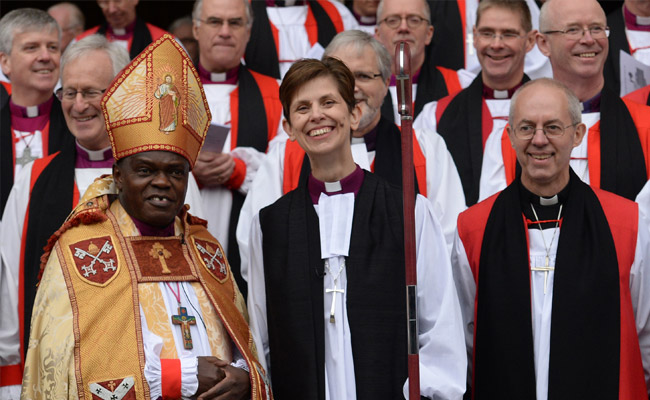For the last week I have been digesting the “Report from the House of Bishops on Marriage and Same Sex Relationships after the Shared Conversations,” known by its shorthand as GS (General Synod) 2055. This “Report” was a document prepared by the Church of England’s Bishops and presented to the Church’s General Synod last week. The perspective of LGBT pressure groups within the Church of England is that they were betrayed by the Bishops’ upholding the Church’s traditional teaching on marriage. Some are even hinting at going ahead with same sex marriage in defiance of the bishops. The disappointment of the LGBT community has been matched by suspicion and criticism from Biblically orthodox Anglicans in the Church of England. To them, GS 2055 is a Trojan Horse. The Bishops’ failure to define boundaries in a clearly Biblical way ensures a theological incoherence that will permit “generous pastoral provision” for LGBT couples to will quickly become facts on the ground (new liturgies and blessings) that make the Church’s teaching on marriage a mere shell.
I sympathize with those suspicions because of my experience with such “Trojan Horse” reports in The Episcopal Church as it marched to gay marriage.
Despite my sympathies, I have tried to find an objective point between the hermeneutics of suspicion and the hermeneutics of hope. I’ve tried to read all 19 pages of GS 2055 inductively, asking what the text really says. All 19 pages are agonizing to read—rather like an essay which reads “on the one hand” and “on the other hand” with no resolution. Except of course for the resolve that “it is hubristic for anyone to propose that there is one definitive answer which solves all the moral, ethical and missiological problems we face.” (para. 7)
There are times when I stand back and admire the analysis that others bring to such a Report. I found Barbara Gauthier’s analysis refreshingly direct and clear when it arrived in my inbox recently. She managed to digest all of the text of GS 2055, the comments and analyses on all sides and to conclude as follows:
“The main takeaways, as I read it, are that
- the current definition of marriage as the union between a man and a woman faithfully for life continues to be the doctrine of the Church of England
- lesbian and gay people are to be welcomed, supported and affirmed by the Church whether they are single, partnered, or civilly married
- lesbian and gay clergy are to be held to a stricter standard in their relationships because of their ordination vow to pattern their moral lives according to the doctrinal teaching of the Church and they may not enter into a civil marriage
- lesbian and gay clergy and ordinands will no longer be questioned about their compliance with the Church’s ban on sexual activity outside of heterosexual marriage for all clergy (“don’t ask, don’t tell”)
- clergy may respond pastorally to lesbian and gay couples with private and informal prayers for their relationship
- clergy may not perform or conduct any service for lesbian and gay couples which would in any way resemble a marriage liturgy
- the unity of the Church of England can be maintained if everyone is committed to “walking together” and will agree to disagree “Christianly”
In other words, it’s pretty much maintaining the status quo here – which should come as a surprise to absolutely no one.”
But this “status quo” raises more questions than it answers, particularly if the bishops see their role as “identifying the next steps – not necessarily toward a “solution” but toward greater clarity about what is at stake and how the good news of God in Jesus Christ can be shared more effectively.” (para. 9) This is the language of mediation and managing conflict. It is not the language of the Apostles in whose feet the Bishops walk, whose job is, and always has been, “guarding the deposit of the faith,” “banishing all strange and erroneous doctrine from the Church” and preserving its Gospel order. It is the language of staying together at all costs even when ways of reading the Scriptures are mutually irreconcilable (see para. 8).
What is at stake here? Is it the unity and survival of the Church as institution? Or is it the survival of the clarity and power of God’s word? Is it “striking a consistent tone and culture” within the Church to encompass those who hold to sharply differing moral judgments on human sexuality and identity? (para. 32) Or is it finding a way to express Christ’s love in fresh ways in our ever changing culture under the received authority of the Scriptures- their consistent clarity, interpretation and application by the Church at all times and in all places?
To these questions I would add the following:
- If this is truly a unique missiological moment (as some have suggested) to find a way to welcome LGBT people and their families and friends into the church, how do the Bishops square the Bible with an increasingly aggressive secular culture that continues to remove all boundaries on human sexuality? And if they cannot do so, which will give way to the other—Biblical values or secular values?
- If the Bishops allow Biblical values to give way to secular values, what Gospel will the Church have to share from its establishment platform? On the other hand, what would it look like for secular values to give way to Biblical values—at some point, will this be perceived as “unwelcoming” to those who refuse to surrender secular values, for whatever reason? Jesus seemed to be able to live with those who turned away from his values—though with great sorrow. Are we willing to follow his example of sorrow and compassion in faithfulness and obedience to God’s final word?
- If the Bishops are serious about “fidelity to Scripture,” why is there a complete absence of Biblical anthropology in this Report, as Bishop Michael Nazir-Ali observes. Doesn’t God’s creative intent and our human condition, as we read it in God’s word, provide the only basis for an alternative vision to the narcissism and nihilism to which secular sexual freedom inevitably leads?
- If this Report represents a way of decision making that is profoundly sensitive to other Churches within the Anglican Communion, and preserving theological unity within the Communion (paras. 3, 59 and 60), why is there no reference whatsoever to the Anglican Communion teaching on human sexuality as declared in Lambeth Resolution I.10 (1998), reaffirmed in the GAFCON Jerusalem Declaration (2008) and reaffirmed yet again in October by the Primates of the Global South meeting in Cairo?
- And why is there no consideration whatsoever of the Joint Statement of the Global South and GAFCON Primates concerning same-sex unions which begins with Biblical anthropology (God’s creative intent, paras. 1-5), affirms unequivocally both the clarity and authority of Scripture (paras. 6-8), offers by contrast “pastoral provision” and care rooted and grounded in repentance and amendment of life through the power of the Holy Spirit (para. 9), and opposes any “vilification or demeaning” of people who are not following God’s creative intent in marriage (para. 10).
- If in “fidelity to Scripture” the Bishops do not feel the Joint Statement of the GS and GAFCON Primates provides a model, or a “consistent tone,” for welcoming LGBT people and their families into the Church, what are their Biblical reasons for ignoring the Statement?
Barbara Gauthier goes on to make a telling observation, from paragraph 65 of the Report:
“65. ….To maintain an unambiguous position on [the] doctrine [of marriage] while enabling a generous freedom for pastoral practice that does not directly and publicly undermine it is entirely consistent with our traditions and is a perfectly coherent approach to take. (emphasis added)
The implication would seem to be that whatever might “directly and publicly” undermine the doctrine of marriage may be perfectly admissible if done “indirectly and privately.” The progressive wing of the Episcopal Church used that ploy for years, surreptitiously establishing facts on the ground, until it couldn’t be ignored any longer.”
Two years after TEC was threatened with discipline by the Primates at Dar Es Salaam in 2007, General Convention 2009 came up with an end run that did not directly change the teaching of Christian marriage as between one man and one woman. Instead, they enacted Resolution C056 which circumvented those boundaries in practice by authorizing bishops and clergy to provide a “generous pastoral approach to meet the needs of [LGBT] members of this Church.”
Within a mere six years the foundations of the Church’s teaching on marriage were so compromised by “facts on the ground” that TEC General Convention 2015 effectively revised the Prayer Book by simply passing a “marriage equality” canon eliminating any language limiting marriage as between one man and one woman. In fact, those “generous pastoral provisions” evolved into the liturgies of the Church.
And so I find myself wondering more about what this Report does not say than what it says. The pledge to develop new Church teaching on areas of Human Sexuality (without regard to the rigorous canonical process of examination by all orders of the Church on doctrinal matters in Synod), the “don’t ask, don’t tell” policy towards partnered gay and lesbian clergy, and the failure of Bishops to effectively discipline clergy who enter into same-sex marriages means the status quo will continue—and with it, the proliferation of “facts on the ground” to undermine the foundations of the Church’s teaching on marriage.
It’s déjà vu all over again. As Gauthier notes, the Church of England is now pulling into the station that TEC left in 2009. How long will it take them, with a few stops along the way, to reach the station TEC left in 2015?
The Rev. Canon Phil Ashey is President & CEO of the American Anglican Council.



